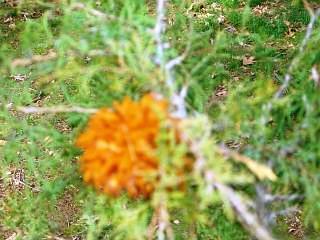Question
 Pine trees of some kin
Pine trees of some kin
I live in Eastern Tn. The evergreens, I think MAY BE A TYPE OF CYPRESS have a cocoon like thing on them with little worm like growths. I was wondering what these are. Haven't seen any movement yet. The more I look at the trees the more I find. What suggestions do you have for me regarding these trees (Not very old)
AnswerThis is cedar apple rust. During warm rainy days in late April and early May, cedar trees infected with the cedar-apple rust fungus will develop bright orange, gelatinous galls.
Cedar-apple rust is an interesting disease. It requires both an apple and cedar or juniper to complete its life cycle. On the cedar, the fungus produces reddish-brown galls that are up to golf-ball size on young twigs. During wet weather these galls swell and begin to push out bright orange gelatinous tubular structures. Wind carries fungal spores from these gelatinous structures to susceptible apple or crabapple cultivars.
Infection occurs when these spores land on a susceptible apple cultivar and moist conditions prevail. Small, yellow spots begin to appear on the upper leaf surface shortly after bloom. Spots gradually enlarge and become a bright yellow-orange color. These brightly colored spots make the disease easy to identify on leaves.
Cedar-apple rust generally does little damage to cedars or junipers. In many cases, the disease is not noticeable except in the spring when the galls are producing the bright orange spore horns. If the disease is very severe, however, twig dieback can occur. Rust galls on small cedars and junipers can be pruned out in late winter or early spring (by April 1). Really I would not be concerned with these on the juniper UNLESS you are growing apples in the are. This can be a serious problem with apples.
Here is a web link to more information on cedar apple rust. http://plantclinic.cornell.edu/FactSheets/cedar-applerust/cedar-applerust.htm






